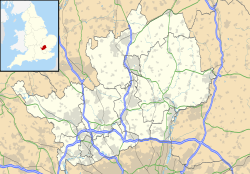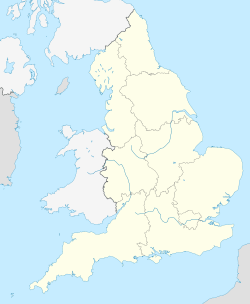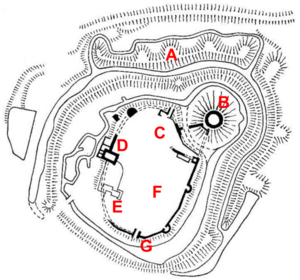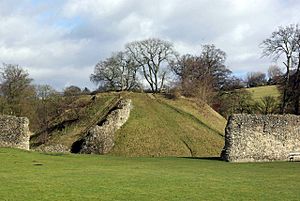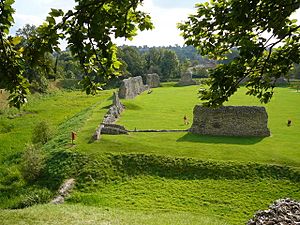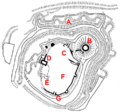Berkhamsted Castle facts for kids
Quick facts for kids Berkhamsted Castle |
|
|---|---|
| Berkhamsted, Hertfordshire in England | |

Exterior walls, seen across the moat
|
|
|
Shown within Hertfordshire
|
|
| Coordinates | 51°45′49″N 000°33′32″W / 51.76361°N 0.55889°W |
| Type | Motte and bailey |
| Site information | |
| Owner | Duchy of Cornwall |
| Operator | English Heritage |
| Open to the public |
Yes |
| Condition | Ruined |
| Site history | |
| Built | 1066 |
| Built by | Robert, Count of Mortain |
| In use | 1066–1495 |
| Materials | Stone |
| Battles/wars | 1216 Siege of Berkhamsted (First Barons' War) |
| Garrison information | |
| Past commanders |
Edward the Black Prince |
Berkhamsted Castle is a historic Norman motte-and-bailey castle located in Berkhamsted, Hertfordshire, England. It was built around 1066 to control an important route between London and the Midlands. Robert of Mortain, who was William the Conqueror's half-brother, likely oversaw its construction and became its first owner.
The castle was designed with strong earthworks and a deer park for hunting. It became a new important center for the area. Over time, different kings gave the castle to their top officials, called chancellors. The castle was made much bigger in the mid-1100s, possibly by Thomas Becket.
In 1216, during a civil war in England, the castle was attacked. Prince Louis of France, who later became King Louis VIII, used siege engines to attack it for twenty days. The castle's defenders eventually had to give up. After the war, the castle was given to Richard, the Earl of Cornwall. He turned it into a grand home and a center for his administration.
Later, in the 1300s, King Edward III gave the castle to his son, Edward, the Black Prince. The Black Prince made the hunting grounds even larger. The castle was also used to hold important prisoners, including John II of France, who was the King of France.
By the late 1400s, the castle was no longer popular and began to fall apart. By the mid-1500s, it was mostly ruins. People even took stones from it to build other houses in the town. In the 1830s, the castle was almost destroyed when the London and Birmingham Railway was being built. Because of this, it became the first building in Britain to be legally protected by Parliament. Today, English Heritage looks after the castle as a popular place for visitors.
Contents
History of Berkhamsted Castle
Building the Castle (1066–1217)
Berkhamsted Castle was built during the Norman conquest of England in 1066. After William the Conqueror won the Battle of Hastings, he moved north towards London. Some old writings suggest that the Archbishop of York surrendered to William in Berkhamsted. William likely ordered the castle to be built there before he went to London.
Berkhamsted was a very important location. It was on a main road that connected London to the Midlands through the Chiltern Hills. William's half-brother, Robert of Mortain, probably managed the building work. He owned the castle by the time the Domesday Book was written.
The castle was built a little away from the main road. This gave enough space for the large earthworks. It also benefited from natural springs that flowed from the hill. The castle had a motte and bailey design. The motte, which is a large mound, was about 40 foot (12 m) high. The bailey, a walled courtyard, was about 500 foot (150 m) by 300 foot (91 m).
A double bank and ditch surrounded the entire castle. Both ditches were filled with water for extra protection. The wider earthworks covered about 11 acres (4.5 ha). Records from 1086 show that a fossarius, a special ditch digger, worked at the castle. Scientists have used Radiocarbon dating to show that the castle's motte was built after 1066.
A large deer park was created around the castle for hunting. The castle was placed right next to this park, with the motte overlooking it. There was also a vineyard near the castle. The old Anglo-Saxon town center moved closer to the castle. Several mills, used for grinding flour, were also there by 1086.
Robert's son, William, later rebelled against King Henry I. Because of this, the castle was taken by the king. Henry then gave Berkhamsted to his chancellor, Ranulf. Sadly, in 1123, Ranulf died after falling off his horse near the castle.
Later, King Henry II gave the castle to Thomas Becket in 1155. Becket was his chancellor. Becket made the castle bigger for his large household. But in 1164, Becket lost the king's favor, and the castle was taken back. King Henry II liked Berkhamsted and used it often himself. By the mid-1100s, the castle had stone walls. It probably had a shell keep and an outer stone wall, likely built by Becket. The bailey was divided into two parts by a wall. A gatehouse led from the castle down into the town. King Henry II also officially recognized Berkhamsted as a town in 1156.
Under King John, the castle was part of the lands given to his second wife, Isabella. In 1206, King John put Geoffrey Fitz Peter in charge of the castle. Geoffrey rebuilt much of the town. He died in 1213, and the castle went to his son, John Fitzgeoffrey.
Tensions grew in England, leading to a civil war between King John and rebellious barons. In early 1215, King John placed a trusted German soldier named Ranulph in charge of Berkhamsted Castle. He also checked its defenses. The civil war started later that year. At first, the rebels lacked siege engines. But in May 1216, Prince Louis of France joined the rebels. He brought heavy siege equipment with him.
King John died in October 1216. In December, Prince Louis attacked Berkhamsted Castle. He used his siege engines, probably trebuchets. They threw many "damnable stones" at the castle for twenty days. During the 1200s, earthworks were built outside the castle walls. These might have been platforms for these trebuchets. The castle's defenders fought bravely. They were allowed to surrender and leave with their weapons. The next year, forces loyal to the young King Henry III defeated the rebels. The castle was then returned to the royal family.
Royal Residence and Decline (1218–1900)
After the civil war, Berkhamsted Castle became strongly linked with the Earls and Dukes of Cornwall. Richard, who was King Henry III's brother, became the Earl of Cornwall. He inherited the castle from his mother, Isabella. Berkhamsted was Richard's favorite castle because it was close to London.
In 1254, Richard built an impressive three-story tower at the castle. He also repaired much of the rest of the castle. Old records say that his building work needed so many carts for timber that local trade was affected. The castle became the main office for the earldom. Richard's nine stewards would bring their financial reports there every year. The town of Berkhamsted also became wealthy from the growing wool trade. Richard died at the castle in 1272, and it passed to his son, Edmund.
The castle then passed through King Edward I and his wife, Margaret. It went to King Edward II. Edward II gave it to his favorite, Piers Gaveston, whom he made Earl of Cornwall. Gaveston was married there in 1307, with King Edward attending. Edward II and Gaveston lost power in 1327. John, Edward's second son, became the new Earl of Cornwall and took over the castle.
When John died, King Edward III took back Berkhamsted Castle. A survey showed it needed many repairs. Edward had not yet improved Windsor Castle, so he used Berkhamsted as his main home. He spent a lot of money renovating it. His son, Edward, the Black Prince, was made Duke of Cornwall. He also used the castle a lot. The Black Prince used the time after the Black Death to make the castle's park bigger. It grew to 991 acres (401 ha).
The castle was used to hold John II of France as a prisoner after he was captured at the Battle of Poitiers. When the Black Prince became ill, he retired to Berkhamsted and died there in 1376.
King Richard II inherited Berkhamsted Castle in 1377. At first, he gave its use to his favorite, Robert de Vere. After de Vere lost power in 1388, it went to John Holland. King Henry IV lived in the castle after he took the throne in 1400. He used it to hold rivals to the throne. During this time, Geoffrey Chaucer, famous for his Canterbury Tales, oversaw repair work at the castle. Both King Henry V and King Henry VI owned the castle. Henry VI used it until he was overthrown in 1461.
King Edward IV took Berkhamsted Castle when he came to power during the Wars of the Roses. In the late 1400s, his mother, Cecily Neville, lived there. But by then, the castle was becoming old-fashioned. It was left empty after her death in 1495. When the historian John Leland visited in the mid-1500s, he found it in "much ruine" and not fit for a king or queen.
In 1580, Queen Elizabeth I leased the castle and its park to Sir Edward Carey. He paid a small rent of one red rose each year. People took stone from the castle to build houses like Berkhamsted Place and a local school in the late 1500s. The castle's park, which was 1,252 acres (507 ha) in 1627, was broken up over the next twenty years. It shrank to only 376 acres (152 ha). The English Civil War in the 1640s did not involve the castle.
In 1761, the castle and the wider estate were separated. The estate was leased to the Duke of Bridgewater. The castle itself remained under the direct control of the Duchy of Cornwall. In 1863, the surrounding estates were sold off to Earl Brownlow. Brownlow also agreed to rent the castle from the duchy for a small payment.
In the 1830s, plans were made to build the new London and Birmingham Railway. The best route for the railway went right through the castle site. However, people were becoming more concerned about protecting old buildings. The local Bridgwater estate also wanted to protect the view from their homes. The castle was specifically protected by a law in 1833. This forced the railway to take a different route across the valley floor. Berkhamsted was the first building in Britain to get this kind of legal protection. Even so, the railway still had to pass through the outer parts of the castle. This was a huge engineering job in 1834, and the castle gatehouse was destroyed.
Between about 1841 and 1897, a soup kitchen operated within the castle ruins. It was set up as a charity by Charlotte Catherine Anne, Countess of Bridgewater. It fed poor farm workers during the winter. Old newspaper reports describe soup and bread being given to hundreds of people from a house in the castle grounds. This was likely the 19th-century keeper's house, which is still there.
Modern Times (20th – 21st centuries)
The Office of Works took over Berkhamsted Castle from the Duchy of Cornwall in 1930. The inner ditch, which had held water, was drained in the 1950s. Today, English Heritage manages the castle as a place for tourists to visit. Historian Isobel Thompson calls it "one of the best surviving motte and bailey castles" in England. The castle is legally protected as an ancient monument.
Images for kids


